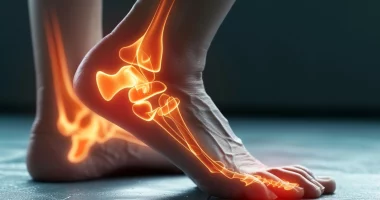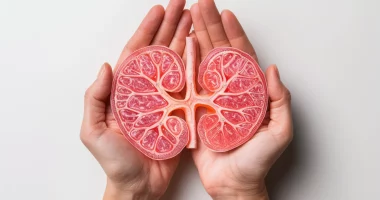Benign skin tumor
General information
Skin neoplasms are benign or malignant tumor lesions caused by pathological overgrowth of tissue cells. Benign neoplasms include warts, moles, nevi, papillomas, lipomas, angiomas, and adenomas.
Benign neoplasms are characterized by slow growth, in which their cellular elements remain within the tumor, not sprouting into adjacent tissues. The tumor, which is evenly increasing, pushes and squeezes healthy tissues, resulting in the latter acting as a capsule. Although benign tumors are atypical, metastasis of their cells is absent.
Under the influence of adverse external or internal stimuli, they (especially nevus) can transform into malignant tumors.
Reasons
Many factors can trigger an uncontrolled cell division process. Still, perhaps the most predisposing can be attributed to frequent skin trauma, in which the cells are forced to renew themselves too often and actively, resulting in a loss of control over this process. In addition, any irradiation (including sun exposure) stimulates the occurrence of skin neoplasms. Genetic predisposition and light skin with numerous moles are also provoking factors in the development of tumors, which in the future can quickly degenerate into malignant neoplasms.
Significantly increasing the risk of various formations on the skin can also increase factors such as frequent aggressive exposure to the skin, skin infections, and chronic skin diseases. In rare cases, metastasis of cancer cells from any other organ can cause a skin neoplasm.
Symptoms
Fibroma—a nodule appears on the skin, more often in exposed areas. The tumor originates in the connective tissue. Provocation may be mosquito bites or traumatization of the skin area. The nodules are pigmented and usually do not progress in development.
Seborrheic warts are small elevations on the skin with a bumpy surface. The tumor is brownish or black. They are also called senile warts because they appear more often in older people.
The formation occurs due to a violation of the localization of basal layer cells. They appear on the scalp and in areas hidden by clothing.
Keratoacanthoma – the tumor occurs more often on the hands and face. A nodule appears, increases in size over a month, and can reach three centimeters in diameter.
Keratoacanthoma looks like a plaque with a depression in the center filled with keratinized cells. About a year after it appears, the mass can resolve on its own.
Papilloma – the formation can be of any shape, similar to a wart. The surface of the neoplasia is irregularly tufted and hairless. It may have horny masses that are easily removed. Papilloma consists of epidermal cells. The color of the formation is brownish or grayish, and it is characterized by slow growth.
Pigmented nevus consists of melanocytes or nevus cells. Its appearance is pigmented spots of black or brownish color. Flat papules can appear on the skin in any location.
These neoplasias are dangerous to degenerate into melanomas. The most located to such a transformation is nevus, localized on the genitals, palms, and soles.
Lipoma is a tumor born from lipocytes, cells of adipose tissue. The skin on the neoplasia is unchanged in color. The formation is soft to the touch. It can grow in size up to ten centimeters. Lipoma can be a single or multiple tumor-like formation under the skin.
Angioma refers to vascular tumors. The neoplasm occurs in the blood vessels of the lymphatic or circulatory system. These are difficult cases to diagnose early because the neoplasia duplicates the vessel’s structure and is not very noticeable at first.
Such neoplasms can occur in internal organs and on the skin; they settle on its surface or in the fat layer. The tumor is dangerous because its presence in the vessel impairs its functioning and thus affects the general health.
Angiomas often appear on the face. They appear as pinkish, red or bluish spots with a flat or bumpy surface.
Diagnosis
Self-diagnosis and regular dispensary examinations are very important in early diagnosis. The doctor’s attention during visual inspection allows him or her to diagnose pathological conditions and skin neoplasms and refer the patient for further examination.
Attention to their health and the health of their loved ones makes it possible to notice changes in moles, pigmentation, and birthmarks in time. And, if there are skin changes without objective reasons, you should be examined by a dermatologist or oncologist, where, based on visual inspection, histological studies and studies of the body’s general state will be confirmed or excluded tumor-like nature of skin neoplasms.
Treatment
Treatment of widespread benign tumors is often surgical. Radiation therapy with soft X-rays is also used. Physiotherapy is aimed at the destruction and death of tumor cells and their removal.
Individual seborrheic warts are destroyed by cryodestruction with liquid nitrogen or other methods for cosmetic reasons or in case of threat of malignization.
Treatment of keratocanthoma is excision of the formation within the unaffected tissue. According to some data, satisfactory results are obtained by local application of cytotoxic agents in treating the tumor.
Skin nevus treatment is also surgical, depending on its size, localization, and clinical manifestations. Large nevi of the face, which can lead to aesthetic disorders, can be excised with one-stage repair with local tissues, transplantation of free skin autograft, or a staged excision.
Nevus, even of small size, subjected to constant trauma (collar, glasses, comb, etc.), removed. If symptoms of tumor activation appear, additional radioisotope diagnostics is required to determine the benignity or malignancy of the process. If the benign nature of the nevus is preserved, it is necessary to perform its excision, and the boundaries of the operation should be expanded. In recent years, cryodestruction has been widely used for the treatment of nevi.
All these treatment options are available in more than 550 hospitals (https://doctor.global/results/diseases/benign-skin-tumor). For example, Removal of benign skin lesions can be done in 31 clinics across Germany for an approximate price of $2,8 K (https://doctor.global/results/europe/germany/all-cities/all-specializations/procedures/removal-of-benign-skin-lesions).


